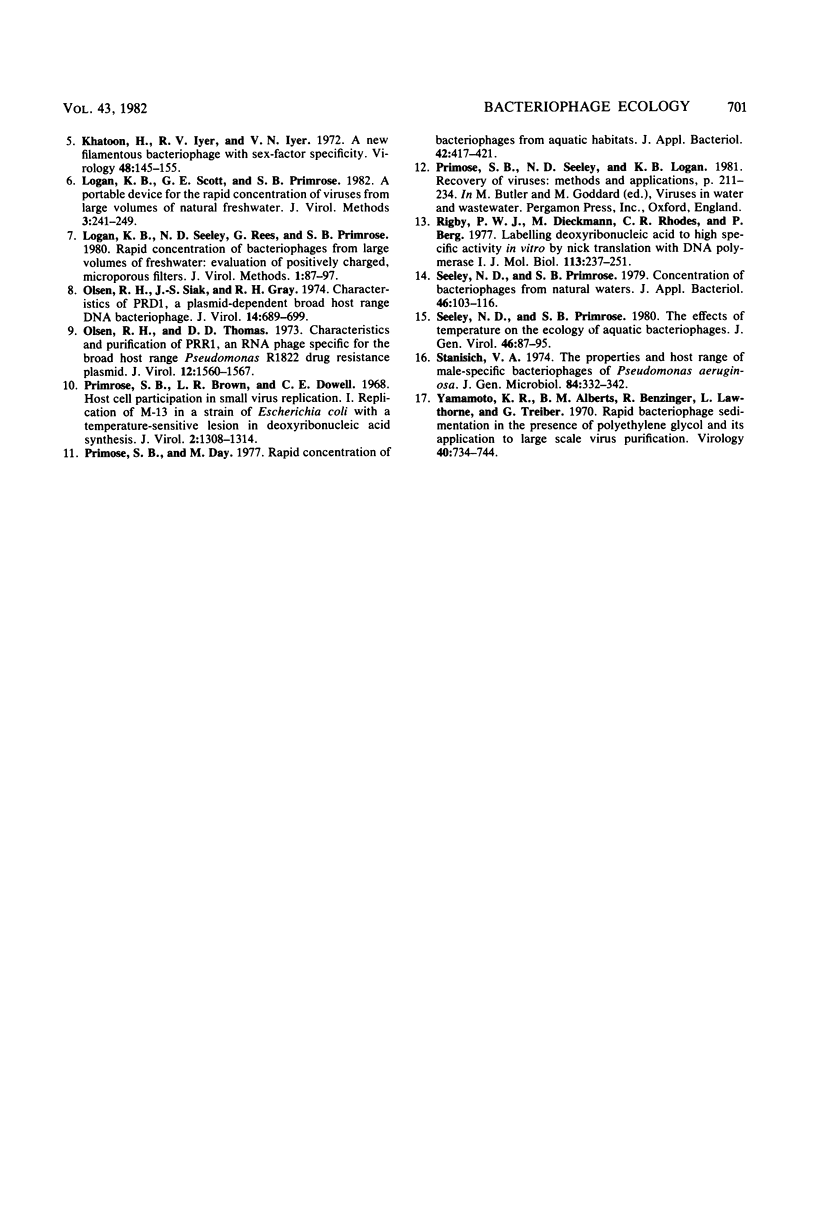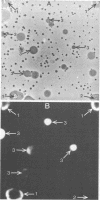Abstract
Methods are described for enumerating the different kinds of bacteriophage present in virus concentrates prepared from 120 liters of water. Although developed specifically for use with coliphages, they should be applicable to viruses infecting other hosts. These methods involve mixed indicators, equilibrium buoyant-density centrifugation, use of enzymes or inhibitors or both, and specific hybridization probes, either alone or in combination. With these methods, it was possible to specifically enumerate filamentous and isometric male-specific (F-specific) phages, the different classes of P-group plasmid-specific phages, φX174-like phages, and λ-like phages. Some applications of these methods, including measurement of virus inactivation in the environment and the extent of fecal pollution, are discussed.
Full text
PDF







Images in this article
Selected References
These references are in PubMed. This may not be the complete list of references from this article.
- Bamford D. H., Rouhiainen L., Takkinen K., Söderlund H. Comparison of the lipid-containing bacteriophages PRD1, PR3, PR4, PR5 and L17. J Gen Virol. 1981 Dec;57(Pt 2):365–373. doi: 10.1099/0022-1317-57-2-365. [DOI] [PubMed] [Google Scholar]
- Benton W. D., Davis R. W. Screening lambdagt recombinant clones by hybridization to single plaques in situ. Science. 1977 Apr 8;196(4286):180–182. doi: 10.1126/science.322279. [DOI] [PubMed] [Google Scholar]
- Colman A., Byers M. J., Primrose S. B., Lyons A. Rapid purification of plasmid DNAs by hydroxyapatite chromatography. Eur J Biochem. 1978 Nov 2;91(1):303–310. doi: 10.1111/j.1432-1033.1978.tb20966.x. [DOI] [PubMed] [Google Scholar]
- Godson G. N. Evolution of phi-chi 174. Isolation of four new phi-chi-like phages and comparison with phi-chi 174. Virology. 1974 Mar;58(1):272–289. doi: 10.1016/0042-6822(74)90161-5. [DOI] [PubMed] [Google Scholar]
- Khatoon H., Iyer R. V., Iyer V. N. A new filamentous bacteriophage with sex-factor specificity. Virology. 1972 Apr;48(1):145–155. doi: 10.1016/0042-6822(72)90122-5. [DOI] [PubMed] [Google Scholar]
- Logan K. B., Rees G. E., Seeley N. D., Primrose S. B. Rapid concentration of bacteriophages from large volumes of freshwater: evaluation of positively charged, microporous filters. J Virol Methods. 1980;1(2):87–97. doi: 10.1016/0166-0934(80)90017-8. [DOI] [PubMed] [Google Scholar]
- Logan K. B., Scott G. E., Seeley N. D., Primrose S. B. A portable device for the rapid concentration of viruses from large volumes of natural freshwater. J Virol Methods. 1981 Nov;3(4):241–249. doi: 10.1016/0166-0934(81)90074-4. [DOI] [PubMed] [Google Scholar]
- Olsen R. H., Siak J. S., Gray R. H. Characteristics of PRD1, a plasmid-dependent broad host range DNA bacteriophage. J Virol. 1974 Sep;14(3):689–699. doi: 10.1128/jvi.14.3.689-699.1974. [DOI] [PMC free article] [PubMed] [Google Scholar]
- Olsen R. H., Thomas D. D. Characteristics and purification of PRR1, an RNA phage specific for the broad host range Pseudomonas R1822 drug resistance plasmid. J Virol. 1973 Dec;12(6):1560–1567. doi: 10.1128/jvi.12.6.1560-1567.1973. [DOI] [PMC free article] [PubMed] [Google Scholar]
- Primrose S. B., Brown L. R., Dowell C. E. Host cell participation in small virus replication. I. Replication of M-13 in a strain of Escherichia coli with a temperature-sensitive lesion in deoxyribonucleic acid synthesis. J Virol. 1968 Nov;2(11):1308–1314. doi: 10.1128/jvi.2.11.1308-1314.1968. [DOI] [PMC free article] [PubMed] [Google Scholar]
- Primrose S. B., Day M. Rapid concentration of bacteriophages from aquatic habitats. J Appl Bacteriol. 1977 Jun;42(3):417–421. doi: 10.1111/j.1365-2672.1977.tb00709.x. [DOI] [PubMed] [Google Scholar]
- Rigby P. W., Dieckmann M., Rhodes C., Berg P. Labeling deoxyribonucleic acid to high specific activity in vitro by nick translation with DNA polymerase I. J Mol Biol. 1977 Jun 15;113(1):237–251. doi: 10.1016/0022-2836(77)90052-3. [DOI] [PubMed] [Google Scholar]
- Seeley N. D., Primrose S. B. Concentration of bacteriophages from natural waters. J Appl Bacteriol. 1979 Feb;46(1):103–116. doi: 10.1111/j.1365-2672.1979.tb02587.x. [DOI] [PubMed] [Google Scholar]
- Stanisich V. A. The properties and host range of male-specific bacteriophages of Pseudomonas aeruginosa. J Gen Microbiol. 1974 Oct;84(2):332–342. doi: 10.1099/00221287-84-2-332. [DOI] [PubMed] [Google Scholar]
- Yamamoto K. R., Alberts B. M., Benzinger R., Lawhorne L., Treiber G. Rapid bacteriophage sedimentation in the presence of polyethylene glycol and its application to large-scale virus purification. Virology. 1970 Mar;40(3):734–744. doi: 10.1016/0042-6822(70)90218-7. [DOI] [PubMed] [Google Scholar]




